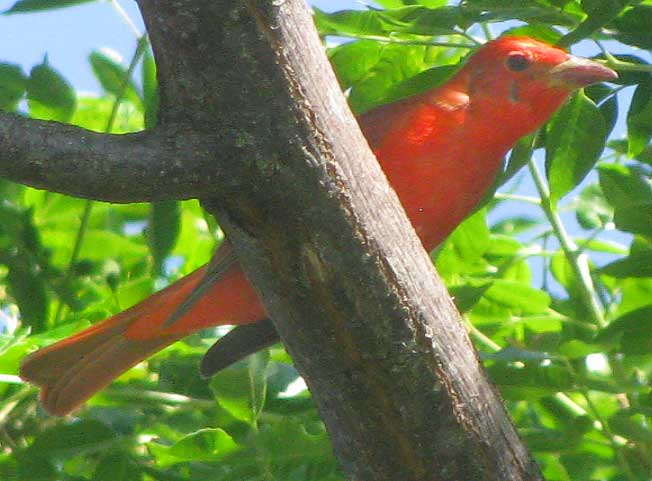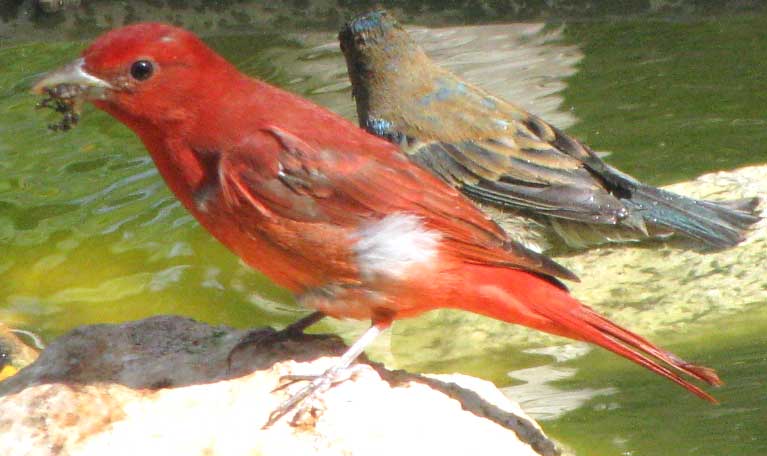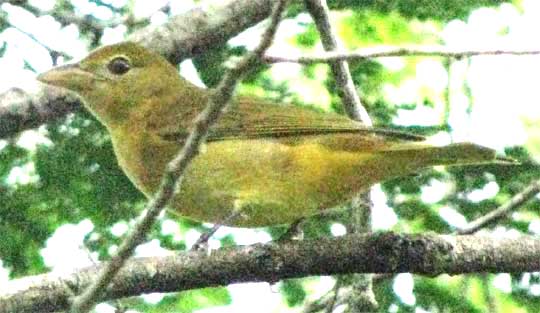Excerpts from Jim Conrad's
Naturalist Newsletter

from the the May 19, 2013 Newsletter issued from the Frio Canyon Nature Education Center in northern Uvalde County, southwestern Texas, on the southern border of the Edwards Plateau; elevation ~1750m (~5750 ft); N29.62°, W99.86°; USA
SUMMER TANAGER
The mulberry trees are producing, which means that mulberry-eating birds create a colorful circus inside the trees. The most brightly colored bird, one who seems to stay inside the trees most of the daylight hours, is a male Summer Tanager, who is shown above after flitting from a mulberry into the garden Chinaberry.
Summer Tanagers are common here during the warm months, overwintering from the southern half of Mexico south through Central America into the northern quarter of South America. During recent years they've been one of my prime birdbath visitors during winters in the Yucatan.
But, here, nowadays you hear them all through the landscape, their easy going, rambling, sweet warble of 15-30 syllables somehow a harmonious uttering for our peaceful summer days. Sometimes they also erupt with a fast, low, down-to-business chicky-tucky-tuk call.
I read that their prime food consists of bees and wasps, but the ones behind the cabin, at least for a few days, simply have been gorging on mulberries.

from the January 30, 2011 Newsletter issued from Hacienda Chichen Resort beside Chichén Itzá ruins, central Yucatán, MÉXICO
MALE SUMMER TANAGER
Summer Tanagers, present in most US southern states during the summer, are common winter residents here. Saturday a bright male landed in the birdbath next to a molting male Indigo Bunting. The tanager carried a grub in his beak and his wing appeared to have lost a few feathers, and some fluffy down feathers showed up as a white splotch on his side, as if an attack had pulled them out of place. This bird seemed to have a story to tell, but all I knew for sure was that he wanted to take a bath after swallowing his grub. That's him above.
from the September 29, 2008 Newsletter issued from near Sabacché, central Yucatán, MÉXICO
A FRIENDLY SUMMER TANAGER
Much fewer migrant birds have arrived for the winter than I was expecting. However, Friday morning when a certain drably colored bird appeared in branches close above me and displayed much more curiosity about my presence than the native slingshot-wary population, I figured I had a visitor from up North. And it was true: As soon as the bird filled my camera's viewfinder I saw that it was either a female or immature Summer Tanager, as shown below.

Actually, I wasn't sure which tanager it was until I studied my Howell's A Guide to The Birds of Mexico and Northern Central America, especially the distribution maps. Then I saw that Summer Tanagers overwinter here, Scarlet Tanagers only pass through on their way to South America, and Hepatic and Western Tanagers don't normally occur here. My friendly visitor was more golden brown than yellow-green, so that made it a Summer, not a Scarlet. Also its beak was more massive than the Scarlet's.
Surely this bird had grown accustomed to humans up North, for its curiosity and willingness to show itself was remarkable. What a world it would be if all animals felt they could trust humans -- and really could -- and came to accompany us on our walks the way this one did me for several minutes.